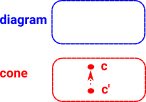Limits and Colimits
A limit is a way to take a diagram and encapsulate its properties into one object as simply as possible.
This is a generalisation that includes:
|
 |
Catagorical Limits
Generalises universal constructions such as:
In some category C we have:
Everything constructed like this is supposed to commute. This is called a cone. |
 |
 |
There may be other objects that have morphisms to all the objects in the diagram. The limit chooses the 'best' one. |
| In this case the 'best' one is the cone which all the others factor through. |  |
 |
To make this more rigorous and categorical we need to define the diagram better. A diagram of shape J in C is a functor from J to C |
More about limits on page here.
Limits
These generate a construction (c) which depends on the diagram such that:
- All triangles commute.
- Any other object c' can be factored through c without loosing information (there is a unique arrow to make the cones commute).
The first condition makes 'c' general enough to capture the essence of the construction.
The second condition makes sure that it is only just general enough (no junk).
| Universal Construction | Universal Cones over Diagram: | |||
|---|---|---|---|---|
terminalThis is a cone over an empty diagram. Therefore the diagram puts no constraints on c. It is the most general object and so any other object can map to it. |
|
|||
productobjects 'a' and 'b' are independent of each other so c needs to be general enough to contain the information in both. More about product on this page. |
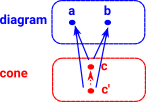 |
|||
arrowNot a necessarily universal construction but I've included it here for completeness. Here there is an arrow between 'a' and 'b' so they are no longer independent.
|
 |
|||
equaliser'c' is a subobject of 'a' on which 'f' and 'g' agree. Monics are equalisers in set or any topos. injective function goes from 'c' to potentially larger objects 'a' and 'b'. In set an injective function defines a subset relationship. In category theory this can be generalised to a monomorphism (monic).
More about equalisers on this page. |
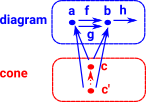 |
|||
pullbackMore about pullback on this page. |
Colimits
| universal cone over diagram: | ||||
|---|---|---|---|---|
Initial |
empty diagram |
|||
SumMore about sum on this page. |
||||
pushout |
||||
coequaliserIn set an surjective function defines an equivalence relationship. In category theory this can be generalised to a epimorphism (epi).
Shows which elements of 'a' are equal to other elements of 'a'. (Can be represented by some subset of a×a). More about co-equalisers on this page. |
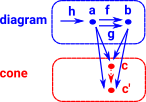 |
Limits and CoLimits in Set
Just to give some intuition here are some diagrams showing the internal set structure.
| universal cones over diagram: | |
|---|---|
terminalnot sure how to show this |
|
productobjects 'a' and 'b' are independent of each other so c needs to be general enough to contain the information in both. |
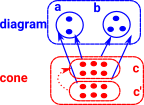 |
arrow injectiveIn this example we cant make the triangle commute with a 3 element set in cone.
|
 |
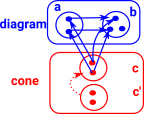 |
|
arrow surjective |
 |
equaliser'c' is the subset of 'a' on which 'f' and 'g' agree. |
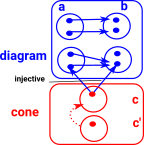 |
co-equaliserSurjective function merges back those elements that don't commute. |
 |
pullback |
Relationship to Type Theory
Category theory is deeply related to type theory. We can therefore see these patterns in the constructors and deconstructors(eliminators) of types.
So can we define a type from a diagram? C represents the type we are trying to construct from a diagram.
As an example, look at product types on this page.
